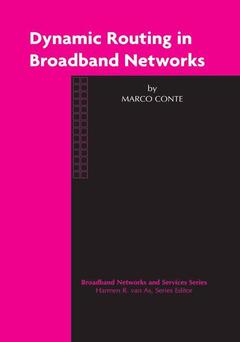Description
Dynamic Routing in Broadband Networks, 2003
Broadband Networks and Services Series, Vol. 3
Author: Conte Marco
Language: English
Keywords
ATM; Asynchronous Transfer Mode; Routing; Switching; network; networks; optimization; simulation
Dynamic Routing in Broadband Networks
Publication date: 10-2012
214 p. · 15.5x23.5 cm · Paperback
Publication date: 10-2012
214 p. · 15.5x23.5 cm · Paperback
Approximative price 105.49 €
Subject to availability at the publisher.
Add to cart
Dynamic routing in broadband networks
Publication date: 11-2002
214 p. · 15.5x23.5 cm · Hardback
Publication date: 11-2002
214 p. · 15.5x23.5 cm · Hardback
Description
/li>Contents
/li>
Dynamic Routing in Broadband Networks focuses on routing in broadband networks based on MPLS (Multiprotocol Label Switching) and ATM (Asynchronous Transfer Mode). The routing methods are based on the theory of Markov decision processes which forms a very accurate framework for on-line route optimization. The author shows the issue of performance optimization and scalability with respect to dynamic routing of logical connections in broadband networks. The methods used are applicable to routing virtual path connections (VPC) and virtual channel connections (VCC) in ATM networks as well as label switched paths (LSP) in MPLS networks. Simulation results and a performance comparison with reference routing are given for the different schemes.
1 Introduction.- 1.1 Overview of this Work.- 1.2 Chapter Overview.- 1.3 Evolution of Broadband Networks.- 1.4 Broadband Network Architectures.- 1.5 Network Protocols.- 1.6 Quality of Service.- 1.7 QoS Routing.- 1.8 Dynamic Routing.- 2 Routing in Telephone and Data Networks.- 2.1 Dynamic Routing in Telephone Networks.- 2.2 Routing in IP-Based Data Networks.- 2.3 Classification of Routing Schemes.- 2.4 Routing Schemes and the Degree of Meshing.- 2.5 Some Selected Algorithms for Routing Computations.- 3 ATM Routing.- 3.1 Asynchronous Transfer Mode.- 3.2 PNNI.- 3.3 The Time Scale Model.- 3.4 Research Efforts in ATM Routing.- 4 Multiprotocol Label Switching.- 4.1 The MPLS Shim Header.- 4.2 Label Switched Paths.- 4.3 MPLS Signaling.- 4.4 MPLS Routing.- 4.5 Traffic Engineering.- 5 Performance Optimization of ATM Routing.- 5.1 Broadband Traffic Models.- 5.2 Brief Overview of the MDP Theory.- 5.3 Theory of MDP Routing.- 5.4 Existing MDP Routing Schemes.- 5.5 New Approach for Multirate MDP Cost Computation.- 5.6 Computation of Initial Offered Loads.- 5.7 Link Load Estimation.- 5.8 The Cost of Unidirectional and Bi-directional Calls.- 5.9 Fairness for Service Requests.- 5.10 Self-Adaptive Cost Tables.- 6 DR/ATM — A Dynamic Routing Scheme.- 6.1 Principles of DR/ATM.- 6.2 Requirements on ATM Routing Scenarios.- 6.3 Path Selection in DR/ATM.- 6.4 The DR/ATM Routing Architecture.- 6.5 VPC Configuration.- 6.6 DR/ATM for Weakly Meshed Networks.- 6.7 Interworking with PNNI Networks.- 6.8 Selection of a Multicast algorithm for DR/ATM.- 6.9 Automatic Adaptation of the Cost Function Tables.- 6.10 Analysis of Requirements on Network Entities.- 7 Implementation of the Simulation Models.- 7.1 Cell-and Connection-Level.- 7.2 The Simulation Tool.- 7.3 The Routing Simulator.- 7.4 DeterminingCAC Parameters at the Cell-level.- 8 Simulation Results and Performance Comparison.- 8.1 Routing Schemes Simulated.- 8.2 Network Scenarios.- 8.3 Results for the Five-Node Fully Meshed Network.- 8.4 Results for the Twenty-Node Fully Meshed Network.- 8.5 Results for the Twenty-Node Strongly Meshed Network.- 8.6 Results for the Twenty-Node Squared Meshed Network.- 8.7 Twenty-Node Squared Meshed Network: Further Results.- 8.8 Twenty-Node Squared Meshed Network: Interworking of Routing Schemes.- 8.9 Multicast Routing Simulations.- 8.10 Routing Adaptability.- 9 Conclusion.- List of Acronyms.- List of Mathematical Symbols.- References.
© 2024 LAVOISIER S.A.S.
These books may interest you

BGP Design and Implementation 72.61 €



